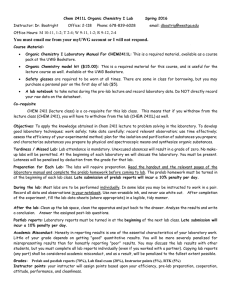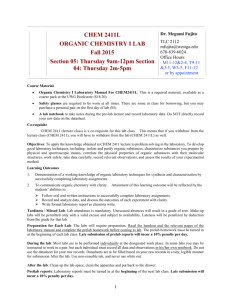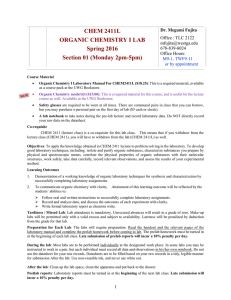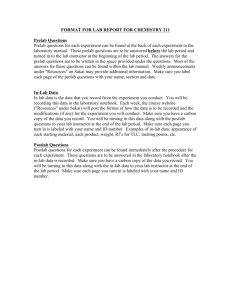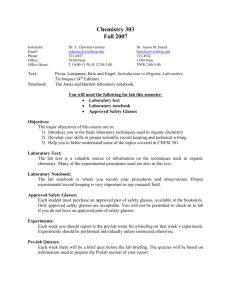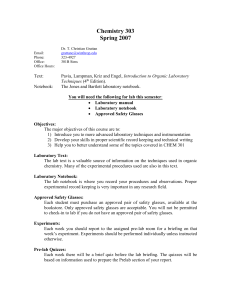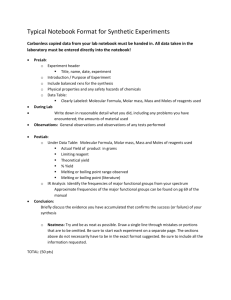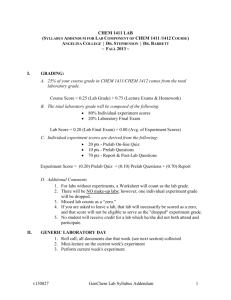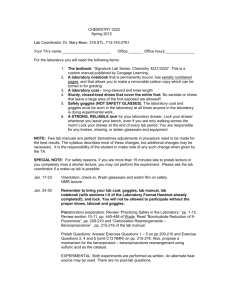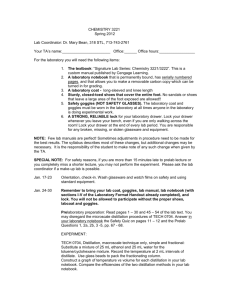Report Guidelines Rev 9-2014 - Chemistry at Winthrop University
advertisement
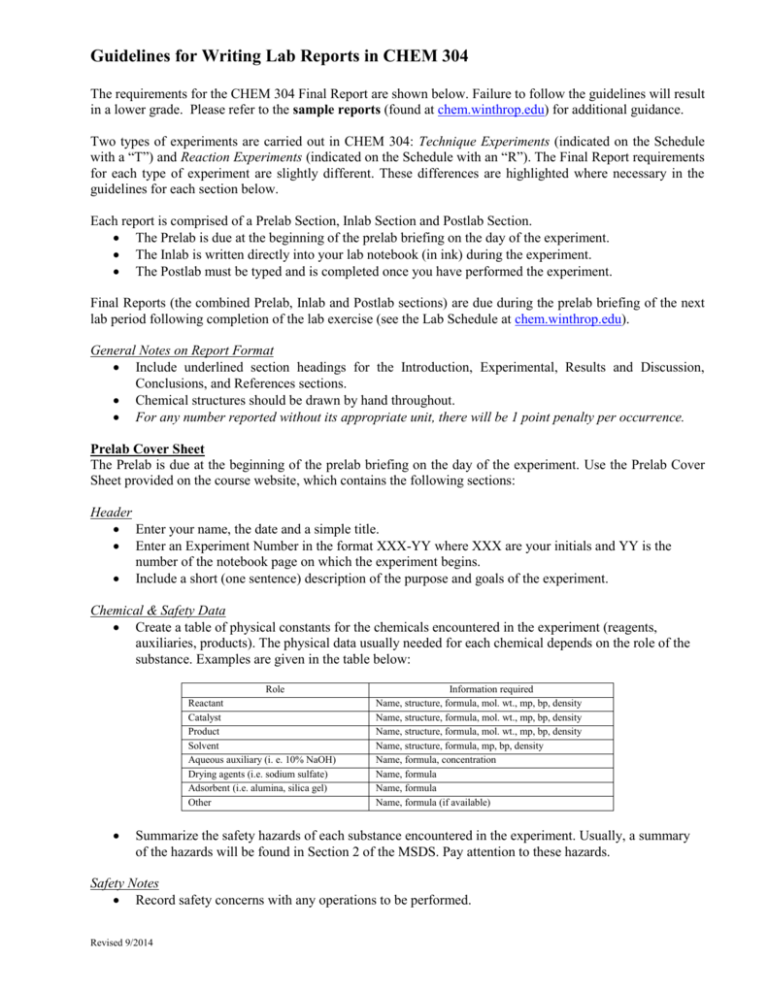
Guidelines for Writing Lab Reports in CHEM 304 The requirements for the CHEM 304 Final Report are shown below. Failure to follow the guidelines will result in a lower grade. Please refer to the sample reports (found at chem.winthrop.edu) for additional guidance. Two types of experiments are carried out in CHEM 304: Technique Experiments (indicated on the Schedule with a “T”) and Reaction Experiments (indicated on the Schedule with an “R”). The Final Report requirements for each type of experiment are slightly different. These differences are highlighted where necessary in the guidelines for each section below. Each report is comprised of a Prelab Section, Inlab Section and Postlab Section. The Prelab is due at the beginning of the prelab briefing on the day of the experiment. The Inlab is written directly into your lab notebook (in ink) during the experiment. The Postlab must be typed and is completed once you have performed the experiment. Final Reports (the combined Prelab, Inlab and Postlab sections) are due during the prelab briefing of the next lab period following completion of the lab exercise (see the Lab Schedule at chem.winthrop.edu). General Notes on Report Format Include underlined section headings for the Introduction, Experimental, Results and Discussion, Conclusions, and References sections. Chemical structures should be drawn by hand throughout. For any number reported without its appropriate unit, there will be 1 point penalty per occurrence. Prelab Cover Sheet The Prelab is due at the beginning of the prelab briefing on the day of the experiment. Use the Prelab Cover Sheet provided on the course website, which contains the following sections: Header Enter your name, the date and a simple title. Enter an Experiment Number in the format XXX-YY where XXX are your initials and YY is the number of the notebook page on which the experiment begins. Include a short (one sentence) description of the purpose and goals of the experiment. Chemical & Safety Data Create a table of physical constants for the chemicals encountered in the experiment (reagents, auxiliaries, products). The physical data usually needed for each chemical depends on the role of the substance. Examples are given in the table below: Role Reactant Catalyst Product Solvent Aqueous auxiliary (i. e. 10% NaOH) Drying agents (i.e. sodium sulfate) Adsorbent (i.e. alumina, silica gel) Other Information required Name, structure, formula, mol. wt., mp, bp, density Name, structure, formula, mol. wt., mp, bp, density Name, structure, formula, mol. wt., mp, bp, density Name, structure, formula, mp, bp, density Name, formula, concentration Name, formula Name, formula Name, formula (if available) Summarize the safety hazards of each substance encountered in the experiment. Usually, a summary of the hazards will be found in Section 2 of the MSDS. Pay attention to these hazards. Safety Notes Record safety concerns with any operations to be performed. Revised 9/2014 Guidelines for Writing Lab Reports in CHEM 304 Inlab The Inlab section is your record of the experiment and is written directly into your lab notebook (in ink) during the experiment. The Inlab contains the following sections: Header Enter your name, the date and a simple title. Enter an Experiment Number in the format XXX-YY where XXX are your initials and YY is the number of the page on which the experiment begins. Include a short (one sentence) description of the purpose and goals of the experiment. Include the name of your lab partner for experiments done in pairs. Procedure & Observations Record everything you do directly into the notebook. Include data (masses, melting points, etc.) and observations (notable color changes, evolution of gas, etc.). DO NOT write data on separate sheets of paper for later transcription. If you make a mistake, cross it out with a single line and write in the correction next to the mistake. Postlab The Postlab must be typed and is completed once you have performed the experiment. For the first three experiments, some Postlab sections will be in the form of a worksheet designed to help you learn how to fully compose these sections on future reports. Title Provide a short title that clearly describes exactly what the experiment involves. For example… “The Synthesis of Ethoxybenzene by Williamson Ether Synthesis from Phenol and Iodoethane and its Analysis by 13C-NMR Spectroscopy.” Note that “Williamson Ether Synthesis” would not be an acceptable title. Introduction Requires an underlined section heading. BRIEFLY summarize the experiment, including its purpose. For Technique Experiments, explain the principles behind the techniques introduced in the experiment. For Reaction Experiments, include balanced equations and mechanisms. Experimental Requires an underlined section heading Formally write up your procedure, data, and observations in a style similar to that in an article from the Journal of Organic Chemistry – one that can be understood and repeated by an organic chemist. Minute details of common organic lab procedures should not be included. For example, write… “The combined organic extracts were dried over anhydrous sodium sulfate” rather than… “Each organic layer was placed in a common 50-mL flask. About 0.1 g of anhydrous sodium sulfate was added and the mixture was swirled. Visible droplets of water were still present, so another 0.1 g portion of sodium sulfate was added and the mixture was vigorously swirled. This was repeated until the organic layer was clear, contained no visible water droplets, and the sodium sulfate had stopped forming clumps.” Include all data collected (e.g. product mass, melting point, spectral data). Revised 9/2014 Guidelines for Writing Lab Reports in CHEM 304 Results and Discussion Requires an underlined section heading Present your data in an easily interpretable form. Use tables, graphs, charts, etc. if needed to make the data easier to interpret. Thoroughly interpret your data and observations. Compare your data to literature data where appropriate (see the course website for useful links). Explain the significance and meaning of your data and observations, and state what you can conclude from them. Discuss any problems or sources of error and how they could be avoided or minimized. Conclusion Requires an underlined section heading. Provide a brief summary of your findings. Indicate whether the experiment a success relative to the statement of purpose. References Requires an underlined section heading. Sources of information must be cited using numbered endnotes, with the citation numbers appearing in the text in the order in which they are first cited. Cite any source used to look up any information (including lab handout, lab text, MSDS, etc.). Answers to Questions Requires an underlined section heading. Answer any questions at the end of the lab handout. Attachments Include hard copies of spectra, chromatograms, etc. at the end of your report. All attachments must have written on them the experiment number and date obtained. Revised 9/2014
